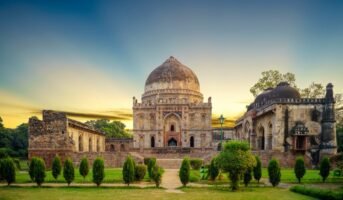The Red Fort in Delhi is not only an architectural marvel but also witness to some of the most crucial events in Indian history. The Delhi Red Fort is known by various other titles like Lal Qalʿah (लाल क़िला in Hindi also spelled Lal Kila or Lal Qila) and Qila-e-Mubarak (the blessed fort).

See also: All about Raigad fort information in English
Red Fort history
Built by the fifth Mughal emperor Shah Jahan in 1648, when he decided to move his capital from Agra to Delhi, the Lal Kila was the palace fort of Shahjahanabad – the king’s new capital also known as Old Delhi. The Red Fort of Delhi is in fact inspired by the Red Fort in Agra, which was built by his grandfather, Akbar the Great. Spread over 49.1815 hectares (256 acres), the Delhi Red Fort Complex also includes the adjacent older fort – the Salimgarh, built by Islam Shah Suri in 1546. This massive walled structure took nearly a decade to complete. Ustad Hamid and Ustad Ahmad of Shah Jahan’s court started the construction in 1638 and completed it in 1648.
Built on the banks of the Yamuna river, whose waters fed the moats surrounding the fort, the octagonal-shaped Lal Qila remained the Mughal Empire’s seat for around 200 years before the British took over.
Also read all about the Agra Fort
Lal Kila architecture
![]()
![]()
The Red Fort of Delhi represents the brilliance of Mughal architecture, mixed with various local building traditions such as Persian, Timurid and Hindu architecture. The Lal Kila has influenced the architecture of key monuments in Delhi, Rajasthan and Uttar Pradesh, built after it.
See also: All about window grill design

Within the fort’s grounds, which are surrounded by 75-ft-high red sandstone walls, are palaces, private chambers of the royal queens, entertainment halls, royal dining areas, projecting balconies, baths, indoor canals (including Nahr-i-Bihisht or stream of paradise), gardens and a mosque. The most prominent structures within the complex include Diwan-e-Aam and Diwan-e-Khas, a typical feature found across most Mughal-era buildings.

![]()
(Khas Mahal)
![]()
(Hall of Private Audience or Diwan-e-Khas at the Lal Qila or Red Fort in Delhi)
The building has two main entry points – the Lahori Gate and the Delhi Gate. While the Lahori Gate is the main entrance to the fort, the Delhi Gate is the public entrance at the southern end of the building.
![]()
See also: The cost of Taj Mahal and other interesting facts about the famous monument
What lies within the Lal Kila Delhi?
|

(Rang Mahal)
See also: Kanch Mahal: An exquisite architectural wonder of the Mughal period
Red Fort: A world heritage site
![]()
Designated a UNESCO World Heritage site in 2007, the Lal Qila, which has also been declared a monument of national importance under the Ancient Monument and Archaeological Sites and Remains Act, 1959, is managed by the Archaeological Survey of India.
The Lal Kila, Delhi, now has museums that display a large variety of historical artefacts. These include the Subhash Chandra Bose Museum, the Museum of 1857, Yaad-e-Jallian, Drishyakala and Azadi Ke Deewane.

(Moti Masjid)
Key facts about Red Fort of Delhi
Red Fort flag hoisting on Independence Day
The prime minister of India unfurls the national flag at the Red Fort every year, on independence day. This has been the tradition since India attained independence from the British on August 15, 1947.
Lal Kila original name
The original name of the building was Quila-e-Mubarak. The British gave the name Red Fort after its massive red sandstone walls while the locals translated that as Lal Quila for the same reason.
Red Fort original colour
Since Delhi did not have the ample supply of red sandstone, the Red Fort was originally made of limestone. Due to the depreciation over time, the structure was painted red by the British at a later stage.
Red Fort: Trial place of the last Mughal
The British tried the last Mughal emperor Bahadur Shah Zafar at the Lal Kila over charges of treason, after which he was sent to Rangoon, now Myanmar.
Red Fort light and sound show
The Lal Kila hosts a 60-minute light and sound show that takes visitors through the history of the monument. You can book the show online or buy tickets from the booths at the fort. While the timing may vary depending on the season, the show is in Hindi between 7:30 pm and 8:30 pm and in English between 9:00 pm and 10:00 pm.
See also: Know all about boundary wall design

Red Fort features on Rs 500 note
The Lal Kila is featured on the back of the new Rs 500 currency note.
See also: Tughlaqabad Fort Delhi
Red Fort timingsVisiting hours: 7:00 AM – 5:30 PM Days open for visiting: Tuesday to Sunday Weekly holiday: Monday Time required for a full tour: 2-3 hours Red Fort entry fee: No fee for children below 15 years; Rs 10 for Indian nationals, citizens of SAARC and BIMSTEC nations; Rs 250 for foreign nationals. Best time to visit: November to February Nearest Metro Stations: Lal Quila (Violet Line), Chandni Chowk (Yellow Line) Red Fort light and sound show tickets: Weekdays: Rs 60 for adults and Rs 20 for children; Weekends and public holidays: Rs 80 for adults and Rs 30 for children. |
Views of Delhi’s majestic Red Fort

(Lahori Gate)
The pink interior of the Red Fort in Delhi
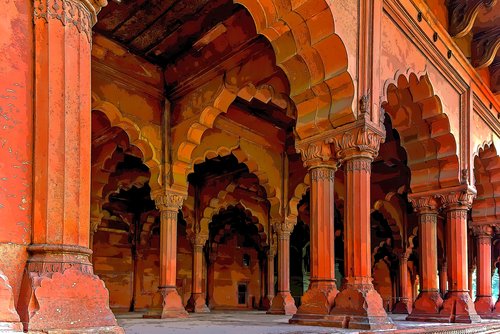
Diwan-e-Khas at the Lal Qila in Delhi
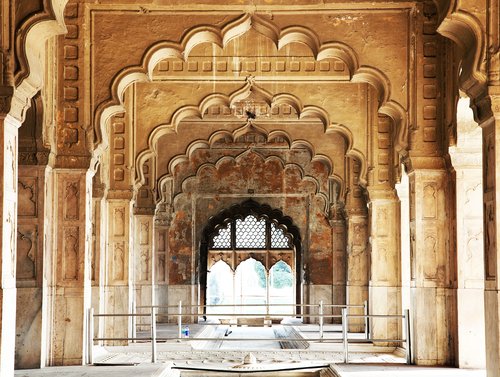
Lahori Gate of the Lal Qila in Delhi
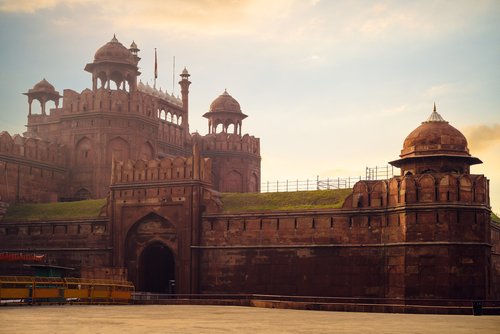
View from the bottom of the Lal Qila in Delhi
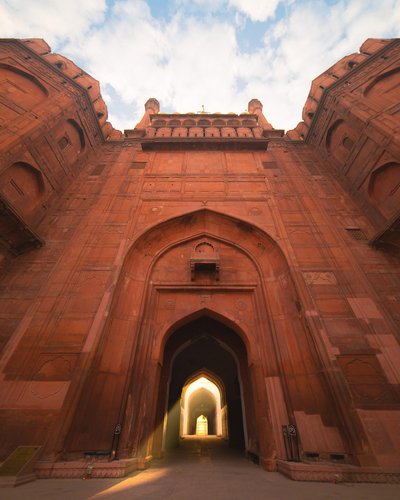
View inside Delhi Red Fort
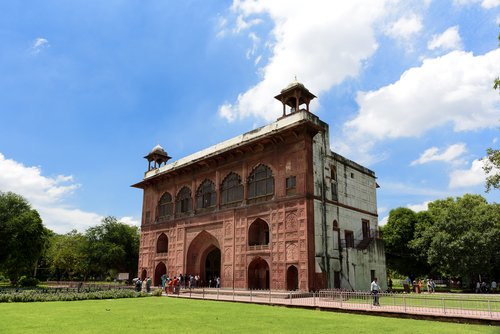
How to reach Red Fort Delhi?
Old Delhi Railway Station
The station is at a 2.3 km distance from the Red Fort in Delhi.
ISBT Kashmiri Gate
The ISBT Kashmiri Gate is 2.7 km from the Red Fort in Delhi.
Red Fort Delhi nearest metro station
The Lal Qila Metro Station is the nearest metro station from the iconic building. Part of the Delhi Metro Violet Line, the Lal Qila Metro Station is 0.3 km from the Red Fort. Exit from gate No 4 to reach the Red Fort from this station.
Lal Qila Station on Violet Line
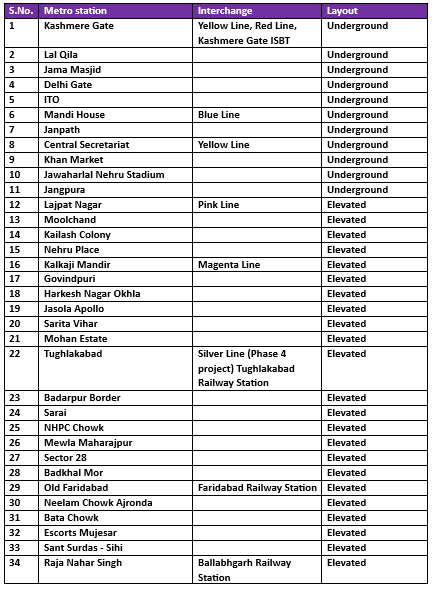
FAQs
Who built the Red Fort?
Mughal emperor Shah Jahan built the Red Fort.
When can one visit the Red Fort?
The monument is open from Tuesday to Sunday between 7 am and 5:30 pm and is closed on Mondays.
How much time would it take for a full tour of the Lal Quila complex?
It would take nearly 2-3 hours to visit the entire monument.
Which metro station is for Red Fort?
The Lal Quila Metro Station on Delhi Metro Violet Line is for the Red Fort.
What is the address of the Red Fort Delhi?
Red Fort Delhi Address: Netaji Subhash Marg, Chandni Chowk, New Delhi, Delhi, 110006, India

An alumna of the Indian Institute of Mass Communication, Dhenkanal, Sunita Mishra brings over 16 years of expertise to the fields of legal matters, financial insights, and property market trends. Recognised for her ability to elucidate complex topics, her articles serve as a go-to resource for home buyers navigating intricate subjects. Through her extensive career, she has been associated with esteemed organisations like the Financial Express, Hindustan Times, Network18, All India Radio, and Business Standard.
In addition to her professional accomplishments, Sunita holds an MA degree in Sanskrit, with a specialisation in Indian Philosophy, from Delhi University. Outside of her work schedule, she likes to unwind by practising Yoga, and pursues her passion for travel.
[email protected]

